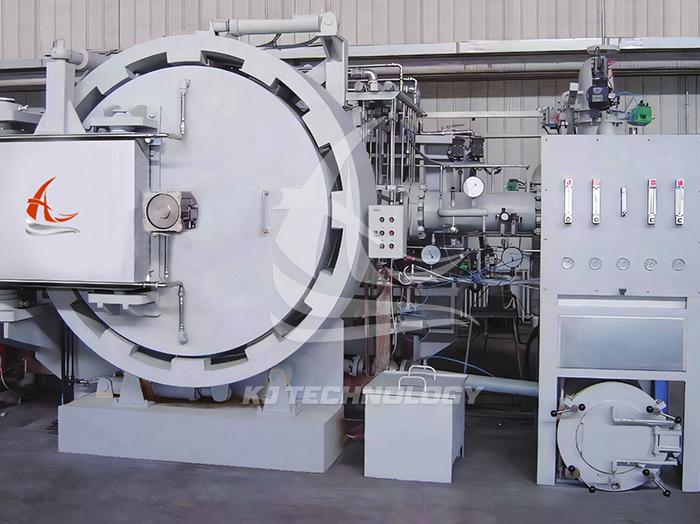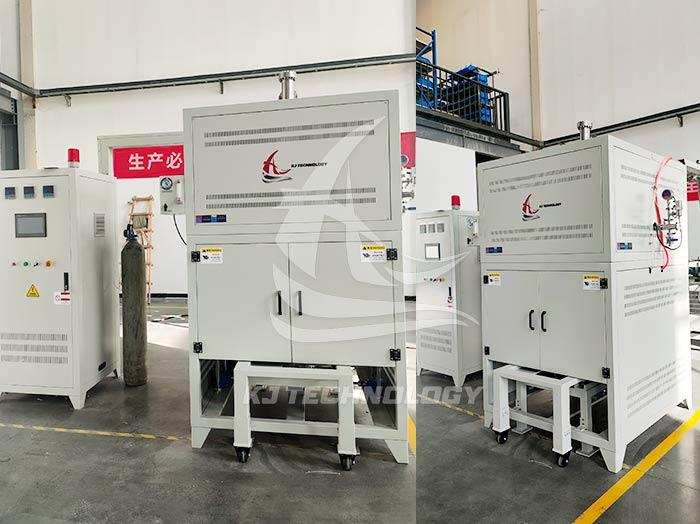Experimental small vacuum furnace annealing experiment
 10-21-2025 Author: KJ technology
10-21-2025 Author: KJ technology
The core of the annealing experiment using a small vacuum furnace is to achieve non oxidative annealing of metal materials through high vacuum environment (usually below 10-2Pa) or inert gas protection, combined with precise temperature control, in order to improve material properties. The following provides a detailed explanation from four dimensions: experimental principles, operating procedures, key parameters, and safety standards:
1. Experimental principle
The role of vacuum environment
The vacuum furnace uses a pumping system (mechanical pump+molecular pump) to reduce the pressure inside the furnace to a high vacuum state (such as 5.0 × 10-4Pa), avoiding the reaction of metals with oxygen, nitrogen, etc. at high temperatures, and preventing oxidation, decarburization, or nitriding. For example, titanium alloys can reduce hydrogen content and improve material toughness during vacuum annealing.
The goal of annealing process
Through three stages of heating, insulation, and cooling, the internal stress of the material is eliminated, the organizational structure is improved, and the physical properties (such as magnetic induction intensity and hardness) are enhanced. For example, after vacuum annealing at 1250-1300 ℃, the magnetic induction intensity of silicon steel sheets can be increased, and the hysteresis loss is significantly reduced.
2. Operation steps
Pre-experiment preparation
Equipment inspection: Confirm that the vacuum system (pump, valve, vacuum gauge), heating system (resistance wire, temperature controller), and cooling system (water cooler) are operating normally.
Workpiece processing: Clean the surface of the workpiece of oil stains and oxide scales, and place them reasonably to avoid uneven heating or collision deformation.
Parameter settings: Set the annealing temperature (such as steel 650-900 ℃), vacuum degree (such as 10-3-10-4Pa), and holding time (such as 30-60 minutes) based on the material properties.
Experimental Procedure
Furnace loading: Place the workpiece into the furnace, close the furnace door and seal it.
Vacuum pumping: Start the mechanical pump to pre pump to below 20Pa, then start the molecular pump to pump to high vacuum (such as 8 × 10-4Pa).
Heating: Introduce inert gas (such as Ar gas) to adjust the pressure to 5-8 Pa, and start heating to the set temperature.
Insulation: Maintain temperature stability and ensure sufficient transformation of material structure.
Cooling: Turn off the heating power and quickly cool down by water or air cooling (such as 100 ℃/min) to avoid grain coarsening.
Sampling: After cooling to below 70 ℃, open the furnace door and take out the workpiece.
3. Key parameter control
degree of vacuum
Steel annealing: The vacuum degree should be below 10-3Pa to prevent decarburization.
Annealing of titanium alloy: The vacuum degree should be below 10-4Pa to avoid hydrogen embrittlement.
Active metals (such as zirconium): need to be protected by Ar gas to prevent nitridation.
temperature control
Heating rate: generally not exceeding 10 ℃/min to avoid cracking caused by thermal stress.
Insulation time: Adjust according to the thickness of the material, for example, 2mm steel plate needs to be insulated for 30 minutes.
Cooling rate: Rapid cooling (such as oil cooling) can refine grains and improve hardness; Slow cooling (such as furnace cooling) can reduce residual stress.
Gas selection
Inert protection: Ar gas is used for annealing stainless steel and copper alloys, and N ₂ gas is used for annealing low carbon steel.
Active reaction: H ₂ gas is used for reducing iron oxide powder, and NH ∝ gas is used for nitriding treatment.
4. Safety regulations
Equipment safety
Regularly check the oil quality and water cooling system of the vacuum pump to avoid leakage or overheating.
Before operation, confirm that the electrical circuit is intact, the grounding is reliable, and touching live parts is prohibited.
Gas safety
Explosion proof devices are required for H ₂ gas experiments, and the exhaust gas is treated by catalytic combustion.
The NH3 gas experiment is conducted in a fume hood, wearing a gas mask.
emergency response
When the vacuum system leaks, immediately turn off the gas source and evacuate personnel.
During a fire, use dry powder fire extinguishers and do not use water to extinguish the fire.








